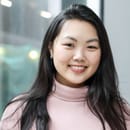At about this time last year, the name “Ada Lovelace” was brought to my attention by a group who was hosting a Wiki-thon to add more pages dedicated to female scientists into Wikipedia’s library. The event was happening on the second Tuesday of October, which I discovered had been dubbed “Ada Lovelace Day”, a day to spotlight the many incredible women in science, technology, engineering, and math (STEM). A quick Google search of “Ada Lovelace Day” will reveal that the celebration began in 2009 in London, UK. It began as a day of blogging about women in technology. The next year, the organizers added a live event with a keynote speaker. In recent years, the live event has evolved to include an entire lineup of celebrated women scientists and engineers, and several independently organized grassroots events have sprung up in other countries, like the Wiki-thon that I happened to come across last year.
To my great fortune, I had the chance to attend Ada Lovelace Live in London this year. Before the official start to the presentations, the event attendees had the chance to mingle over drinks and browse the book stall. A quick look around the room revealed that the event had attracted folks of all ages: there were mothers and fathers with their children, there were secondary school girls who came with their friends, and there were young working adults too. As the night progressed, I was pleased to find out that the event was enjoyable by all as well.
The speaker lineup was impressive and spectacular. The speakers came from a diverse set of backgrounds and each had their unique area of expertise. Each speaker also delivered their presentations differently. Yolanda Ohene told a story of how she went about collecting images of her internal organs and used this story to explain how MRIs have evolved. Dr. Katie Steckles explained the mysterious lives of mathematicians and their love for unsolved puzzles. She even gave the audience a simple example of one: the perfect cuboid. Roni Savage spoke about her personal experience venturing into entrepreneurship as an engineering geologist. Dr. Sally Le Page began her talk with examples of sexual dimorphism and their biased representation in the history of evolutionary biology (it turns out, we often characterize a species by how the males look and know little about their female counterparts). She then followed up with how this has influenced gender representations of animals in popular media, animal studies, and even clinical studies. Dr. Bala Chaudhary spoke about her work studying beneficial microbes in soils and detailed how her and her team went about figuring out how these microbes transport themselves. Hayley Loren gave the audience a quiz about energy production and consumption and reminded us that we are all part of the movement towards cleaner energy.
Dr. Jocelyn Bell Burnell was the final speaker of the evening. She spoke about the historical struggle for gender equality in science at higher levels of education. As a seasoned veteran in the fight for gender equality in STEM, her presentation was peppered with her frank sense of humour. She described how she and a group of senior female scientists came together to create the Athena SWAN awards to encourage universities to become more women friendly. They had realized that perhaps the best way to encourage university leadership to promote the advancement of women in STEM (unfortunately) would be to make it into a competition with some financial incentive. Eventually, the program got picked up by the UK Chief Medical Officer, who made it a requirement for academic departments applying for funding to hold the Athena SWAN Silver Award. Since then, the Athena SWAN charter has expanded to include arts, humanities, social sciences, and law departments as well. Other countries have begun to adopt similar charters.
The work of Dr. Bell Burnell beyond the establishment of Athena SWAN is just as, if not more, remarkable. As a postgraduate student in astrophysics, she made significant contributions to the discovery of the first pulsars, which are rapidly spinning neutron stars that emit beams of radiation that we can detect on Earth. This discovery netted her supervisor, Antony Hewish, the Nobel Prize in Physics in 1974 while Bell Burnell’s contributions went unrecognized. In 2018, however, she was awarded the Special Breakthrough Prize in Fundamental Physics. She decided to donate the entire £2.3 million in prize money to help students from groups that are currently underrepresented in physics to pursue a PhD in physics.
Ada Lovelace Live 2019 brought together a phenomenal lineup of women scientists and engineers. Their presentations were fun, full of character, and inspiring. The night finished off with a performance by comedian and “geek songstress” Helen Arney, who sang the periodic table song (with ukulele accompaniment) to celebrate the 150th anniversary of the Periodic Table of Chemical Elements.
Information obtained from:
https://beta.iop.org/launch-bell-burnell-graduate-scholarship-fund
https://www.iop.org/about/awards/president/medallists/page_69815.html
Video Source:
https://www.youtube.com/watch?v=F0AAgqt0g9U
Images taken by author.


